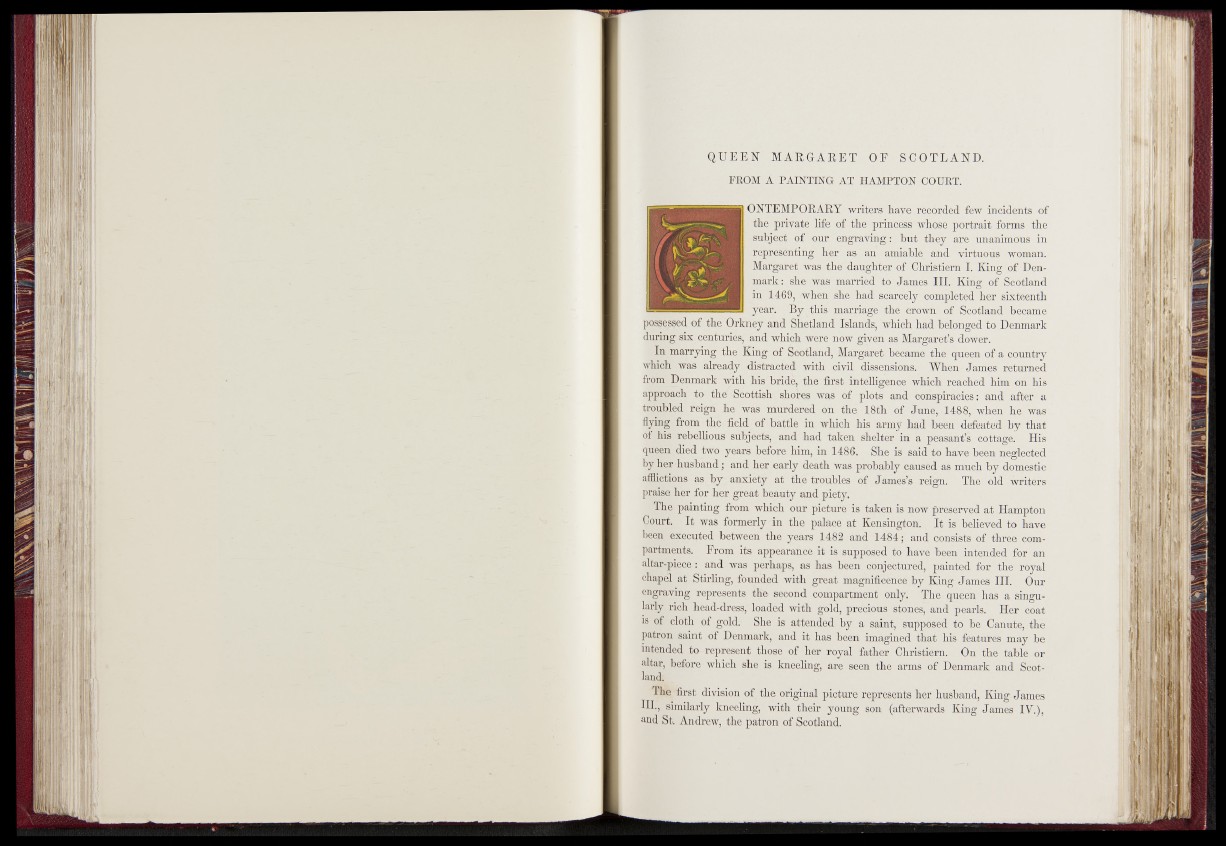
Q Ç E EN MA:RjejpBET OF'- SCOTLAND.
FROM A PAINTING AT HlÉWMMBbTK.^.
ONTEMPORARY writers have recorded few incidents of
B ^ ÿ r iy aw ^ H o f theinrinfte'ss'-^MmEjSortrti.tfX1forms the
subject of our engraving : b u t ^ ^ S are'unanimous in
hr representing K æ ||is an aniinble/^'and -virtuous woman.
■ Margaret was the daughter "of Christiem L ‘King of Den-
kmark : |s^'%as married ^^afcSg’s-jlll. King' oflSeotiamd
in 1469, when4, she had fté&cely^cp^^^ü'dvher sixteenth
fcjjeaf. ' By this marriage me ‘crown1“ of- Scotland': became
posgepsed of the .Orkney and »Shetland Islands, which ‘^^^^ffilonged to Denmark
during six centuries, and whipb were nawSgppn ^Margaret's dower/M*
jin manning the King of Scotland, Margaret became the queen «û'fia cqufitry
was-d^eady distracted with ci%dl- dissensions.! - .When-James returned
frOTï/Denmark with his bride, the first intelldgehc^lwhich/.reached him on-'tfiifi
a®pach to g ^ aM ^ p flh» shores was of 'pléfs and cpn^iràcies ; and ;aftfef. a
ta b led |r e i^ r ;^ was murdered -qn the IStVfpf June, J®Ü<when he was
tfwng from the. field of battle" in which his army had been‘defeated^Jiy ' that
°f his^gbellious subject, and had taken shelter in a peasant’s cottage. His
queen J^iedJwp' years before him, in 1486, «.She is said'fo have been neglected
III her husband; and her early death was probably causêd as much byv<&mestic
afflictions as ^by^ anxiety at thp troubles qf James’s reign. The old writers
praise her for her great beauty and piety.'
The. painting from which our picture is taken is*n©Y}p^eserved at Hampton
Court. It was formerly-in the palace at Kensington.It is believed to have
beqa'executed between the years ,1482 and 1484; and #oi^ists o£three compartments.
From its appearance it iAsupubsM’fd%#e';bêen;intpndedrfor an
altar-piece : and was perhaps, as has been conjeçtured, pjahte’d^ipr the royal
chapel at Stirling, founded with great magnificence hypping James III. Our
engraving represents the- Second compartment only. The (mt|h|has a singularly
rich head-dress, loaded with gold,' precious 'stones, ahdWestflg. Her coat
is of cloth of goldr She is attended by a saint, supposed to 'be Canute, the
patron saint of Denmark, and it has been imagined ffl^t his features may be
intended to represent those of her royal father Christiem. On tie table or
altar, before which she is kneeling, are seen the arms^bf Denmark andvSc'pt-f*
land,
The^first division of the original picture représenta her husband, King. James
HI., similarly kneeling, with their young son (afterwards King James IV.),
and St. Andrew, the patron of Scotland.